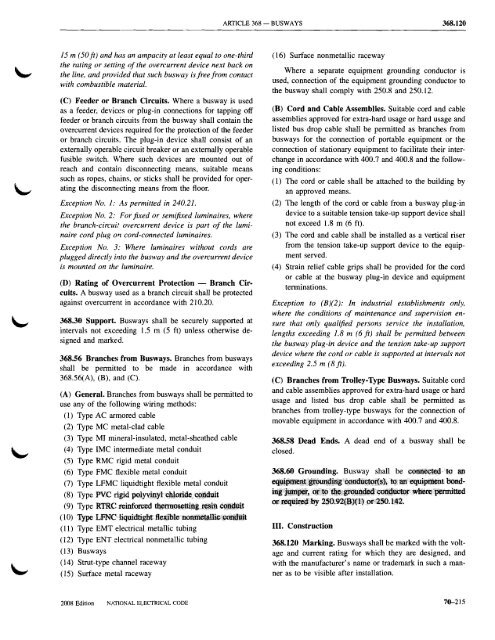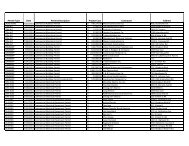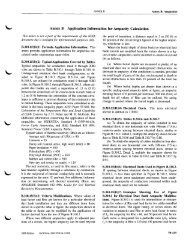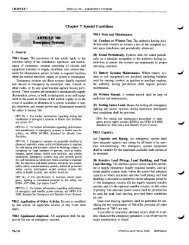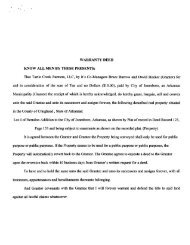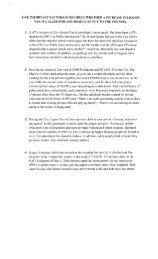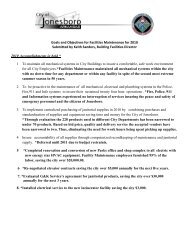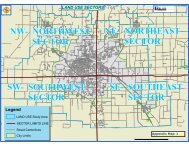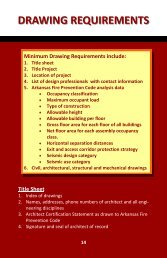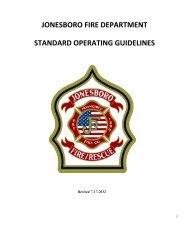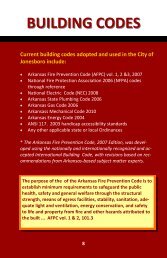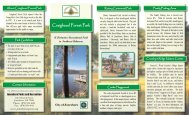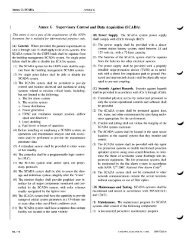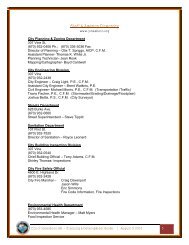Chapter 3 Wiring Methods and Materials
Chapter 3 Wiring Methods and Materials
Chapter 3 Wiring Methods and Materials
Create successful ePaper yourself
Turn your PDF publications into a flip-book with our unique Google optimized e-Paper software.
ARTICLE 368 - BUSWAYS 368.120<br />
15 m (50ft) <strong>and</strong> has an ampacity at least equal to one-third<br />
the rating or setting of the overcurrent device next back on<br />
the line, <strong>and</strong> provided that such busway is free from contact<br />
with combustible material.<br />
(C) Feeder or Branch Circuits. Where a busway is used<br />
as a feeder, devices or plug-in connections for tapping off<br />
feeder or branch circuits from the busway shall contain the<br />
overcurrent devices required for the protection of the feeder<br />
or branch circuits. The plug-in device shall consist of an<br />
externally operable circuit breaker or an externally operable<br />
fusible switch. Where such devices are mounted out of<br />
reach <strong>and</strong> contain disconnecting means, suitable means<br />
such as ropes, chains, or sticks shall be provided for operating<br />
the disconnecting means from the floor.<br />
Exception No.1: As permitted in 240.21.<br />
Exception No.2: For jixed or semijixed luminaires, where<br />
the branch-circuit overcurrent device is part of the lumi<br />
not exceed 1.8 m (6 ft).<br />
naire cord plug on cord-connected luminaires.<br />
Exception No.3: Where luminaires without cords are<br />
plugged directly into the busway <strong>and</strong> the overcurrent device<br />
is mounted on the luminaire.<br />
(D) Rating of Overcurrent Protection - Branch Circuits.<br />
A busway used as a branch circuit shall be protected<br />
against overcurrent in accordance with 210.20.<br />
368.30 Support. Busways shall be securely supported at<br />
intervals not exceeding 1.5 m (5 ft) unless otherwise designed<br />
<strong>and</strong> marked.<br />
368.56 Branches from Busways. Branches from busways<br />
shall be permitted to be made in accordance with<br />
368.56(A), (B), <strong>and</strong> (C).<br />
(A) General. Branches from busways shall be permitted to<br />
use any of the following wiring methods:<br />
(1) Type AC armored cable<br />
(2) Type MC metal-clad cable<br />
(3) Type MJ mineral-insulated, metal-sheathed cable<br />
(4) Type IMC intermediate metal conduit<br />
(5) Type RMC rigid metal conduit<br />
(6) Type FMC flexible metal conduit<br />
(7) Type LFMC liquidtight flexible metal conduit<br />
(8) Type PVC rigid polY~~YlqhLonl.ieeQ~id\,lit<br />
(9) Type R.1'RCteIDforoed tq~!)~tt1!!JJgel,'~"!n ~it<br />
(10) l)fpe Ll"NCliquidtigbtfle~ihlent>nm~llicdi~qm:t<br />
(11) Type EMT electrical metallic tubing<br />
(12) Type ENT electrical nonmetallic tubing<br />
(13) Busways<br />
(14) Strut-type channel raceway<br />
(15) Surface metal raceway<br />
(16) Surface nonmetallic raceway<br />
Where a separate equipment grounding conductor is<br />
used, connection of the equipment grounding conductor to<br />
the busway shall comply with 250.8 <strong>and</strong> 250.12.<br />
(B) Cord <strong>and</strong> Cable Assemblies. Suitable cord <strong>and</strong> cable<br />
assemblies approved for extra-hard usage or hard usage <strong>and</strong><br />
listed bus drop cable shall be permitted as branches from<br />
busways for the connection of portable equipment or the<br />
connection of stationary equipment to facilitate their interchange<br />
in accordance with 400.7 <strong>and</strong> 400.8 <strong>and</strong> the following<br />
conditions:<br />
(1) The cord or cable shall be attached to the building by<br />
an approved means.<br />
(2) The length of the cord or cable from a busway plug-in<br />
device to a suitable tension take-up support device shall<br />
(3) The cord <strong>and</strong> cable shall be installed as a vertical riser<br />
from the tension take-up support device to the equipment<br />
served.<br />
(4) Strain relief cable grips shall be provided for the cord<br />
or cable at the busway plug-in device <strong>and</strong> equipment<br />
terminations.<br />
Exception to (B )(2): In industrial establishments only,<br />
where the conditions of maintenance <strong>and</strong> supervision ensure<br />
that only qualified persons service the installation,<br />
lengths exceeding 1.8 m (6 ft) shall be permitted between<br />
the busway plug-in device <strong>and</strong> the tension take-up support<br />
device where the cord or cable is supported at intervals not<br />
exceeding 2.5 m (8 ft).<br />
(C) Branches from Trolley-Type Busways. Suitable cord<br />
<strong>and</strong> cable assemblies approved for extra-hard usage or hard<br />
usage <strong>and</strong> listed bus drop cable shall be permitted as<br />
branches from trolley-type busways for the connection of<br />
movable equipment in accordance with 400.7 <strong>and</strong> 400.8.<br />
368.58 Dead Ends. A dead end of a busway shall be<br />
closed.<br />
368.60 Grounding. Busway shall be connected eto an<br />
eqwpmentgtounding oondUetc>r(s),to an equipment bondiDg<br />
j~, or to ·tbegrou~eondoctor wberepermitted<br />
or required by 250.92(8)(1) or 250.142.<br />
III. Construction<br />
368.120 Marking. Busways shall be marked with the voltage<br />
<strong>and</strong> current rating for which they are designed, <strong>and</strong><br />
with the manufacturer's name or trademark in such a manner<br />
as to be visible after installation.<br />
2008 Edition NP:fIONAL ELECTRICAL CODE<br />
70-215


